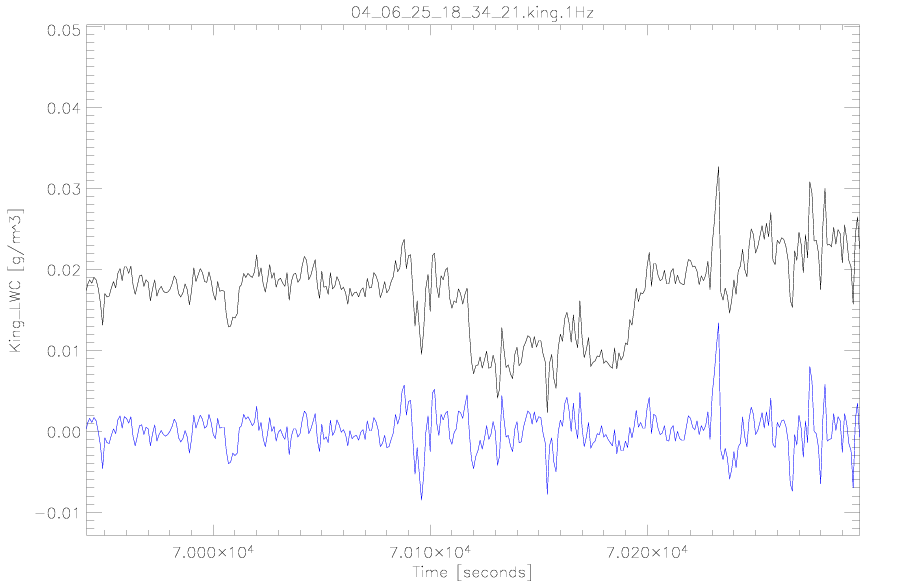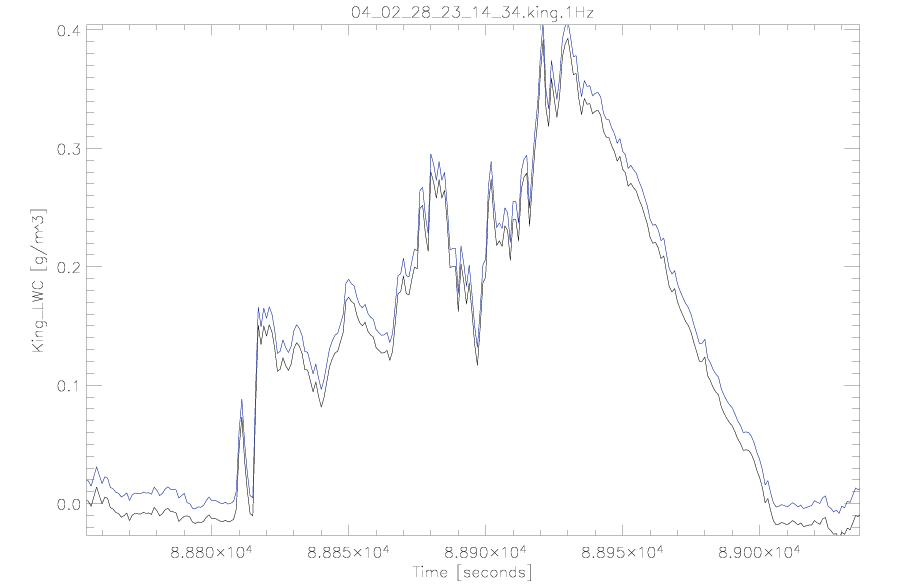
During the processing of the LWC data it is necessary to apply a correction to the data due to the baseline (out of cloud) not being zero. The offset is found in the baseline values of the LWC when the airplane is out of cloud. In theory the value of the LWC should be zero when flying in clear air. However, when the LWC values for a flight are plotted it shows that the baseline values are not zero and can deviate as much as plus or minus .05 grams per cubic meter. This is due to inaccuracies in the dry term of the King power because of changes in pressure and temperature throughout the flight. This affects the accuracy of the data points when the King probe does measure liquid water because the values shift with an offset of the baseline values.
A subroutine, called king2lwc, is used to shift the baseline values to near zero. This is done by first calculating the LWC and then use FSSP concentration data to determine when the plane is out of cloud, calculate an average offset value for a specific time interval right before entering in cloud, and subtract this offset from the data until a new average offset is calculated. The first step in this process is to read in the FSSP total concentration data. Since it is 4Hz data it needs to be converted to 25Hz data to match up with the 25Hz LWC data. This is done by assigning each of the four data values in each second to the six or seven prior data values that would lie in one second of 25Hz data, since there are 6.25 25Hz points for every 4Hz point in one second. The FSSP concentration data is used to determine when the airplane is in and out of cloud. A value for the FSSP concentration must be determined that constitutes a cloud. According to flight data from Febuary 28, 2004 at approximately 87650 seconds from midnight concentrations above 0.2 #/cc gave measurable FSSP LWC values of about .05 g/m^3. Therefore, total concetration used in the subroutine is 0.2 #/cc to determine when the airplane is in cloud. A loop is done to calculate the offset value starting 10 seconds after the start of the flight. The loop checks the data from a point in the flight to 10 seconds prior. If the plane is out of cloud during this whole duration the values of the LWC (the offset values) are averaged and this is the offset value for that point. If at any time during this duration the plane is in cloud, meaning the FSSP concentration is above 0.2 #/cc at any point during this duration, then the offset value is the last offset value calculated out of cloud. If there is not yet an offset value a missing value code is inserted for the adjusted LWC at this point. Another loop preforms the same process only in reverse, starting 10 seconds from the end of the flight and going until the start of the flight. The two offset values, offset_forward and offset_back, are averaged and this new value, offset_avg, is the offset value for each point. The purpose for a forward and backward offset is to weight both the baseline values before and after the plane enters cloud when adjusting LWC values in cloud.
The only problem with this procedure is if the plane changes altitude considerably or if the temperature changes considerably in the time between one offset value and a new calculated offset, such as when the plane flies through cloud for a long period of time. A change in pressure or temperature will affect the offset value of the LWC and if it is not recalculated for a long period of time the change in adjusted LWC will be sudden and drastic and look suspicious.

